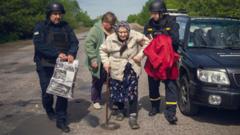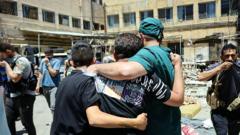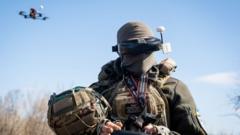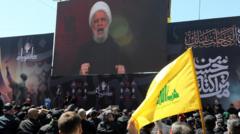As Russian forces make slow but steady gains in the Sumy region, Ukrainian officials hint at a potential strategy to create buffer zones. Although recent advancements seem minor, their implications for resource distribution and future peace negotiations cannot be underestimated.
Russian Troop Movements in Sumy Region: A Strategic Push for Buffer Zones

Russian Troop Movements in Sumy Region: A Strategic Push for Buffer Zones
Recent advancements by Russian forces in Ukraine's Sumy region may signal efforts to establish buffer zones along the border, prompting concerns and a focus on military resource allocation.
Russian forces are reportedly advancing into the northeastern region of Sumy, Ukraine, with officials suggesting that this move might be part of a broader strategy to establish "buffer zones" along the border. Oleh Hryhorov, the head of the Sumy region, disclosed that Russian troops have taken control of four villages, while fighting continues near other locations in an effort to solidify such a buffer. The Russian government claims to have captured six villages, and President Vladimir Putin recently announced intentions to create "security buffer zones" to enhance support for Russian territories near the Ukrainian borders of Kharkiv, Sumy, and Chernihiv.
Hryhorov's communications on social media highlight ongoing military confrontations in the area, reiterating the aim of establishing these buffer zones. However, Ukrainian authorities have not officially confirmed the presence of Russian troops in Sumy, citing the sensitivity of the situation. While conflict reports exist, specifics about troop advancements remain unverified by the military leadership.
Ukrainian President Volodymyr Zelensky referred on Monday to Russia's "preparation for new offensives," underscoring the heightened tension in Sumy. A monitoring group, Deep State, had recorded Russian control of four Ukrainian villages even before Hryhorov's announcement, suggesting sustained military activity since March.
Military specialists have observed that Russia's advance is gradual, moving approximately 1km (0.6 miles) over the past two weeks. Colonel Vadym Mysnyk, a representative of the ground forces, noted that Russian tactics primarily involve small mobile groups using motorbikes to avoid detection, as larger armored vehicles risk interception by surveillance drones. The region, however, continues to experience heavy artillery and airstrikes from Russia.
Recent attacks have targeted civilian infrastructure in Sumy, leading to hundreds of evacuations from 202 nearby settlements, which account for a significant percentage of the provincial communities. Experts suggest that while Russia aims to capture the strategic Donbas, the Sumy advances are attempts to distract Ukrainian forces and stretch their defensive capabilities. Despite these efforts, analysts conclude that there poses no immediate threat of a major Russian breakthrough in Sumy, as Ukrainian forces reportedly have stabilized the frontline over several months.
While Russia's tactical maneuvers in Sumy remain under scrutiny, Ukrainian defenses, fortified since the onset of the invasion, are seen as more capable of repelling incursions than in early 2022. Real assessments indicate that Russia would struggle to project larger forces effectively into North Ukraine unless its priorities shift.




















